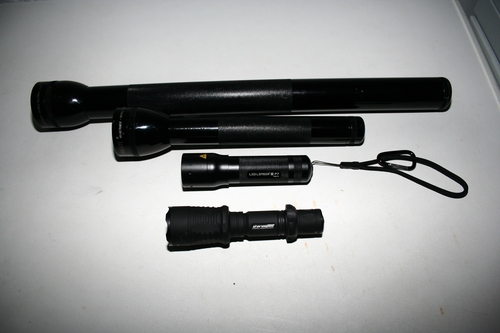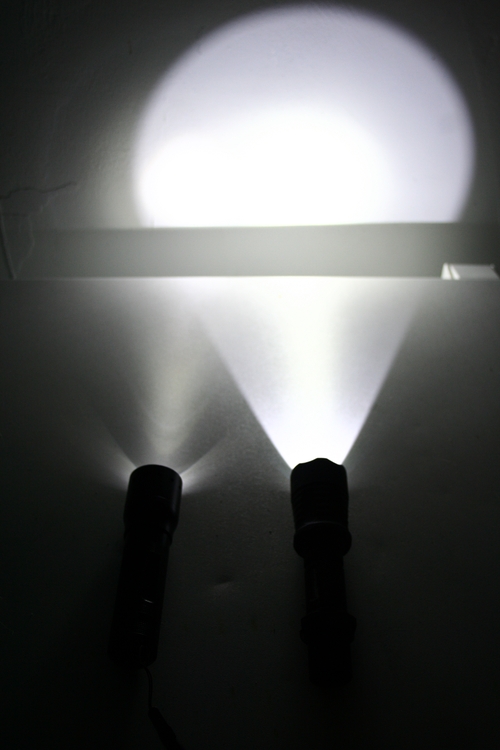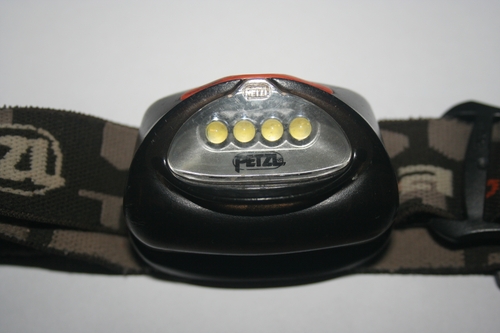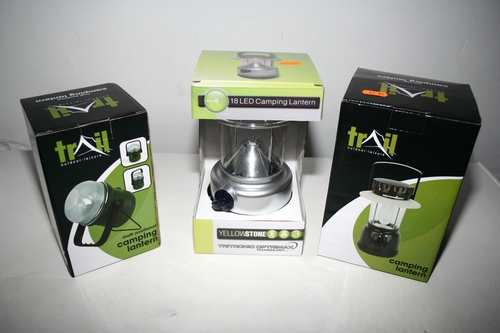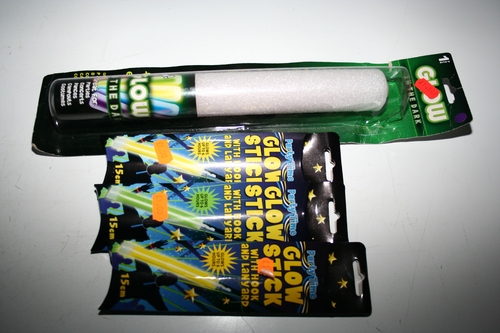Torches & Torchlight...
|
Going camping? You’re going to need a torch! Away from mains electricity, doing anything after dark is a nightmare without torchlight to ease your way.
And don’t forget, unless you’re on your own, one torch just isn’t enough! From hand-helds and head-torches to lanterns, super-bright LED’s and even mobile phones, the choice of torches and the devices they are incorporated into seems endless and the price range almost boundless! But that’s the beauty of it. Whatever your requirement, there’s a torch out there for you! The knack is to pick the one that does what you need! A super-bright beam that throws a pin sharp spot at 500 yards may be great if you’re part of the Tactical Firearms Unit, but not so handy if you’re just trying to cook burgers on the BBQ or give little Johnny or Jenny their bedtime tale. And don’t forget the flip side of all that light at one end, is the battery power you have to put in at the other. Torchlight that makes campsites like daylight for one night, could be costly in batteries if you’re under canvass for a fortnight! You’ll also find other campers tire quickly of over illumination. First because they came camping in the countryside to get away from the “bright lights”, but secondly because having a torch shone in your face at night hurts your eyes! Head-torch users, for example, will know how brilliant they are for freeing up both hands and shedding light exactly where you want it. But you’ll also know the importance of setting the torch angle and level of illumination! If all you’re seeing is screwed up faces and the palms of other people’s hands, you’re definitely getting it wrong! For this reason, Dorset Camper’s top tip on head torches is, if you can’t adjust the brightness and the angle, don’t get it, unless you are a strictly solitary camper or want to be! That said, head torches are amazing. Dorset Camper has been using a Petzl four LED job for years and it’s superb for camping, car mechanics, outdoor work, DIY and a whole host of other bits and pieces. Fired by just three AAA batteries it lasts for ages and has three lamp settings and a strobe. There are certainly cheaper head torches on the market, but the build quality on the Petzl is good for the money and it’s nice and light in both senses. And it’s small enough not to get in the way, so you’ll probably forget you’re even wearing it! When it comes to more robust torch designs, Maglites are a classic - probably the iconic torch. They come in a variety of sizes from the very small to the very large, but all pretty much built around the same concept -a really tough anodised aluminium tube with batteries and a light in it. They are the brick outhouse of torches, but a stylish and highly functional one. All Maglite’s main torches, from the mini right up to the almost half-metre-long six D- Cell jobs have variable beams that can give a soft flood or a longer range beam. You can even take the top off, stand them on end and use them like a candle if you want to! Although not sold by Maglite as “waterproof”, as far as most campers are concerned they are so amazingly “water resistant” that nothing much wet is going to be a problem unless you also need an aqualung and a decompression chamber! Maglites are seriously good torches. The DC team has several. They aren’t cheap, but are extremely well-built (in the USA). And a bit like they used to say of a man and his pipe, a Maglite can become a bit of a hobby! Spares, should you need them, are available and you can register your torch’s unique ID with Maglite. One of the simplest ways to “upgrade” an older Maglite is to change the bulb it uses. They all come with a spare in the end cap, which is helpful, but you can also buy extra bright Xenon bulbs to shed an even brighter, whiter light. LED variants are also now available either as an upgrade or original kit and increase Maglite’s already impressive battery life as well as brightness. Maglite torches are built to last for years and can be bished, bashed and dropped in ways that would destroy lesser bits of kit, which is probably why they are often quoted as the torch of choice for law-enforcers and security staff, who are reliant on their torches and prone to bish and bash them more than others. They also shine plenty of light as far as you’re likely to want it. If there are any downsides to Maglites it’s that being of a more traditional style, you need one hand to hold them and, with the metal casing and batteries, the bigger ones can be a bit lumpish. The good news is that switching to rechargeable batteries can make them a touch lighter - but not much. Maglite do make their own rechargeable torches, but the guys and gals at Dorset Camper have taken to buying discount store re-chargeable batteries and using those for their existing lights. They work fine on Mini Maglites, C-Cell and D-Cell variants, although we’ve not tried them on Maglite LEDs…mostly because we haven’t got one! But also because the Maglite’s we’ve got do a great job anyway! If you don’t want or need a big lump of a torch Maglite do offer smaller bright LED lights too. But there are plenty of others out there, from the cheap and cheerful to more pricey high performers. The LED Lenser P7 for example is an impressive piece of kit you can pick up for between £30 to £40. It has a simple push-button on off switch on the cap which also switches the torch between its two power modes. The beam is focusable using a simple sliding lens, giving either a nice sharp, bright beam or a wider flood. From just four AAA batteries the LED Lenser P7 delivers an impressive 200 lumens of light, enough to throw a nice white beam up to 210 metres on fresh batteries, Lenser say, and we don’t doubt it. Although at that distance we’ve found it’s right at its useful limits as a spot. That said, for camping use, the LED Lenser P7 is small, light, durable, comes with a lanyard and holster and on the lower power output setting should last for up to 64 hours on full batteries. Although, understandably there will be some drop in light with declining charge, we think this is a really handy piece of kit for outward bound types, if you want to spend the money. If this is the sort of performance you need and you don’t mind spending, may be, half as much again, the Armytek Predator is truly impressive. It is pretty much the same size as the Lenser P7, but throws out over three times the light! It boasts a whopping 400 metre beam on its most powerful, 670 lumen, setting. This is way more than any sane camper will ever need, except in the most extreme of emergencies, and will definitely annoy your neighbours! Which makes it really useful that the Armytek Predator has multiple power settings from 670 lumens down to six, as well as a strobe. Armytek state quite clearly that this torch, built around a Cree XP-G2 R5 LED, was designed with the special forces and hunters in mind. Getting to grips with its power settings is not child’s play but you wouldn’t want one playing with it anyway. It does have good features for campers too, not least of which is that it has “full brightness stabilisation” to ensure a constant level of light throughout the battery cycle. It also boasts an impressive 155 hours of burn time on the lowest, six lumen, “Firefly” setting. But, all that light, functionality and burn duration means some fairly impressive batteries are needed. Unlike the Lenser P7’s “triple As”, the Predator, uses either two CR123a or a single Lithium-ion 18650 rechargeable. Neither are currently as widely available, say, as C-Cells, D-Cells, AA or AAA batteries. CR123a batteries can be bought at more specialised electrical retailers, camera shops or off the net, but they cost around £5 each. So £10 or more per fill up. This makes the added cost of re-chargeables and a charger seem like a better deal in the long term. But makes a torch like the Predator, which is made by the Canadian Company Armytek, whose strap line is “the most technically advance flashlights in the world”, seem like an expensive solution to lighting for all but the most specialised of camping usage. (And be careful of additional taxes on importation, if you buy one direct from the manufacturer on the internet.) After all, for the price of the batteries needed to fire the Armytek Predator, you could buy a cheap torch and a set of bog standard batteries needed to power it. Cheap torches aren’t built to last, but they’ll be good enough to get you and the kids back and forth to the toilet at night. And on the plus side, if the kids want to shine their beams around, they aren’t going to start annoying everyone else or risk searing people’s eyelids shut! So whilst you might not want to be totally reliant on a cheap and cheerful torch when you’re camping, having a few of them ready to dish out makes lots of sense. Wind-up torches can also be a good option. You’re never going to be left without light because of a flat battery, making them a fairly reliable and cheap-to-run source of illumination. Wind-up torches need not be expensive to buy, but their big “health warning” is that you need to make sure they’re fully charged before bedtime. Few things are more annoying and disturbing to sleeping camp-mates than the whine of a wind-up being cranked back to life in the wee small hours of the morning! Although not quite as loud, you might as well be spinning up a WW2 air raid siren! Many mobiles and other devices have some sort of torch built in. These can be really handy emergency standbys for camping, not least because it’s probably something you’re already carrying around in your pocket. But don’t forget, when you’re out in the sticks, the most important job for you phone is to help you keep in touch, especially in case of emergency. So don’t be tempted to rely on your mobile device as a source of light unless you really have to, especially if you also use your device for a lot of Face-Tweets and Twitter-Booking! One last thought, depending on the sort of camping you’re doing, the best torch outside the tent, may not be the best torch for inside the tent. With the exception of head-torches, which go wherever you go, not all torches are that “handy” once you put them down. Maglite’s “candle mode” is good, if you can find somewhere to stand it up. Others can be hung from a lanyard inside your tent, as can lantern type lights, assuming your tent has something sturdy enough to hang a torch or lantern from - an increasing number of modern tents large and small don’t. This interior lighting issue can make an Electric Hook-up an attractive option if you happen to be on a permanent campsite. But if you like your camping more back to nature, a battery lantern you can hang or stand to shed light is a good bet, although you’re not going to want to lug one around if you’re walking or travelling light. Glow-sticks are another solution to the lighting issue. Relatively cheap and increasingly available in sizes that make them useful for much more than waving around at festivals or on the end of a fishing rod, these one-use illuminations are a great favourite with kids and are really handy for all the rest of us, especially when deployed as tent night lights. So, there you have it. A huge range of options and choices to make before you decide how you’re going to keep your camping trip an illuminating one. In all likelihood, with the exception of those travelling light and/or on their own, most campers are going to need several sources of light from a variety of torches, lanterns and other devices. Family campers are likely to want at least one really good, sturdy torch and a selection of cheaper ones just for getting from “A to pee”! However, there’s one thing that should never be on the list for interior tent lighting - candles. The fire safety advice for this from the professionals is simple. Don’t do it. Ever. It is far too easy in a tent environment for candles, night-lights and tea-lights to get knocked or blown over. The consequences if they do can be disproportionately bad. Tents and sleeping bags burn hot, bright and very fast…and no batteries are needed! |
There’s one thing that should never be on the list for interior tent lighting - candles... Don’t do it. ... Tents and sleeping bags burn hot, bright and very fast…and no batteries are needed!..."
|
